|
Guide to
Choosing a Quality PCI Communication Board
The PCI
bus specification was designed to take the guesswork out
of choosing and installing add-in boards. Unlike the ISA
bus, where each board had to be jumper configured by
hand, then incorporated into an existing system at a
specific address and IRQ that did not conflict with
anything else installed in that system, the PCI bus was
supposed to let the system itself take care of
everything. By developing a strict set of hardware and
software parameters, the architects of PCI mapped out a
system by which PCI cards could be allocated resources
by the Operating System. This way the OS itself could
solve and resolve any addressing or interrupt conflicts
occurring as a result of multiple PCI boards coexisting
with each other and with other system devices--without
user intervention. However, a PCI system is only as
strong as its weakest link. In order for the system to
consistently function properly, all installed PCI boards
must completely adhere to all aspects of the PCI
specification, and in a perfect world they would. But,
complete adherence to the exacting PCI specification not
only requires extensive engineering expertise, it also
requires the purchase of top-quality components and
meticulous board design and manufacturing.
Quatech
has been manufacturing communication boards for over 20
years, so we have the expertise to do it right. We are
also committed to providing only top-quality boards and
to investing the necessary resources to ensure that
every Quatech PCI board complies with all aspects of the
PCI specification as closely as possible. Unfortunately,
not all companies have the same high standards we do.
Therefore, users need to remember that just because a
board is calling itself "PCI" and fits into a computer's
PCI slot, that does not mean that it correctly
implements the PCI specification. While a non-compliant
PCI board may seem to work when it is first installed,
it might cause problems when combined with other PCI
boards (especially other non-compliant boards), or when
moved to a different motherboard, or when the PCI bus is
heavily stressed. Is that really a chance you are
willing to take with your system?
We know
that Quatech boards aren't your only choice, but we
truly believe that there aren't any better ones. The
chart below details the important PCI specification
compliance issues to keep in mind when evaluating PCI
boards. The following page highlights the design
elements you should look for in a quality PCI board, and
shows you what is missing in a non-compliant one.
|
Compliance Issue |
Importance |
Quatech Boards |
other manufacturers |
|
All unused 5V and 3.3V power pins are plated on
the connector (goldfingers) |
Better data integrity because high-speed PCI
signals use the power pins for return paths |
YES! |
sometimes, often omitted when "cutting corners" |
|
All 3.3V power pins are decoupled from ground
with capacitors |
Better data integrity because high-speed PCI
signals use the power pins for return paths |
YES! |
rare, ground return path capacitors are often
omitted |
|
All PCI signal lines have one and only one load.
(connected to only one pin on one component on
the board) |
Better data integrity because the PCI bus is
extremely sensitive to signal loading |
YES! |
usually, but sometimes violated |
|
JTAG boundary scan chain intact if unused
(connect TDI to TDO signals) |
JTAG boundary scan systems can work with the
board installed |
YES! |
extremely rare |
|
Trace length of 1.5" or less on PCI signals |
PCI signals rely on specific travel times up and
down the bus. Proper trace lengths ensure data
integrity |
YES! |
usually, but sometimes violated |
|
PCI clock trace is 2.5" ±0.1" in length |
The PCI clock signal timing is particularly
critical. All other PCI signals depend on
accurate clock delivery |
YES! |
often violated |
|
Full PCI configuration space implemented |
So
that plug-and-play really works |
YES! |
almost always, but there are some exceptions |
|
Look
closely at the PCI card you are considering
buying. Does it comply with all aspects of
the PCI specification? Quatech boards do.
Can you really afford the potential
aggravation of using a non-compliant board
in your system?
|
|
Do you see blank spaces on the edge connector
instead of a complete row of gold-plated pins? |
|
Notice the two tight rows of "gold fingers" on
the Quatech board. This indicates that all PCI
signals and 3.3V power pins are plated, even
those that are unused. The result is better data
integrity because high-speed PCI signals use the
power pins for return paths.
 |
|
Notice the loosely spaced goldfingers and the
large gaps on the non-compliant board. This
indicates that not all pins are plated, and that
data integrity may be compromised.
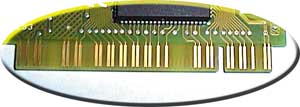 |
|
Do you see large "pools" or "grids" of ground
signals running all over the board? |
|
Notice that there are no grids apparent on the
surface of the Quatech board. This is because
all Quatech boards have a four layer board
design using separate layers for power, ground
and signals thus reducing noise and enhancing
signal integrity.
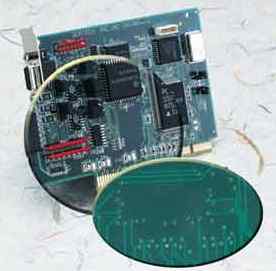 |
|
Notice the grids of ground signals on the front
and back of the non-compliant board. This
indicates the lack of a separate ground layer
and complicates signal routing. This makes the
board more susceptible to noise and can
compromise signal integrity.
Front of board
 |
Back of board
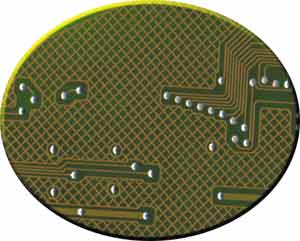 |
|
Is your board truly Plug & Play? Or, do you
see jumpers for setting basic configuration
parameters such as address? |
|
The Quatech board contains a controller chip in
which all PCI configuration registers are
properly implemented. This means that the PCI
BIOS can use the information stored on the chip
to automatically configure the Quatech board,
making it truly Plug & Play.
 |
|
The non-compliant board has no controller chip,
and basic configuration settings such as address
and IRQ must be selected manually via jumpers on
the board. Not only is this board not Plug &
Play, it has the potential to conflict with
other PCI devices in the system.
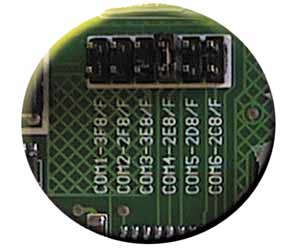 |
|
Do you NOT see a row of tiny capacitors
(usually rectangular) just above the edge
connector on the front or back of the board? |
|
Capacitors which connect the power signal to a
ground are part of the PCI specification and are
designed to filter out noise. As it is fully PCI
compliant, the Quatech board includes these
capacitors. The capacitors also promote signal
integrity, as high-speed PCI signals use the
power pins for return paths.
 |
|
Notice that the non compliant board is missing
the required capacitors. This omission makes it
particularly vulnerable to noise problems and
loss of signal integrity in high-speed
operations.
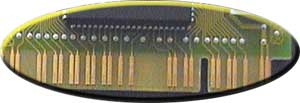 |
|